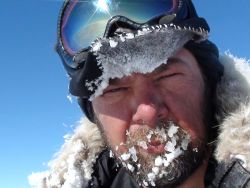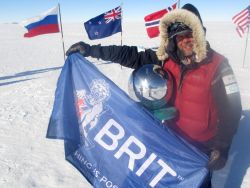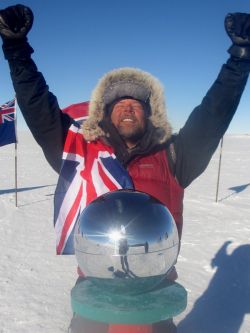Wood: Committed to Raising Awareness about Climate Change
Published on 02.03.2012 - North South Solo Expedition -Leg 2
Before the announcement of the possibility of giving up the second leg of his adventure -reaching the NP directly after having conquered the SP- we had the chance to speak to Marc Wood about his solo trip to the SP and his commitment to raising awareness about Climate Change.
Mark tells ExploraPoles about his Educational Schools Programme to raise awareness about climate change and encourage students to take action, recounts the challenges he faced during his time on the ice in Antarctica, and gives an update on his plans to tackle the second leg of the expedition in the Arctic.
What was your motivation to do the North South Solo Expedition?
The idea was to do an expedition to the South Pole and then follow that immediately with an expedition to the North Pole. I’ve finished the Antarctic part of the expedition, and I’m currently preparing for the next part of it in the Arctic.
I decided to do the two poles back to back in order to do a tougher expedition that would garner media interest and to get students from around the world to support my Educational Schools Programme, which goes on alongside every expedition I go on. The idea is to get students to become aware of climate change and what they can do about it.
Each time I go on expedition, I communicate directly with students in their classrooms from extreme places on the planet via Skype, satellite phone or social networking sites. I want them to not only experience the expedition themselves, but also to be able to look at the planet in a different way so that they can take responsibility for the planet they live on.
How did you first become interested in raising awareness about climate change?
I became interested through my own ignorance, really. I’ve gone through life doing polar expeditions. I don’t claim to be an expert on climate change. I’m not a scientist or anyone who’s ever studied climate or anything like that. But I have seen changes in the Polar Regions in the travels I’ve done over the last 10 years. I’ve seen how fragile this planet can be and how much a small change at the Poles can make a massive difference to other areas of the planet.
So I think I have a responsibility when I go out on expedition to communicate about what’s happening with as many people as possible, to tell how the ice is changing in certain areas, for example. I’m not laying down a scientific opinion. All I’m doing is giving a nice, honest opinion as an ordinary person who’s noticing these things as I’m travelling across these extreme areas. That’s how I see my role as a professional explorer and adventurer – to communicate with as many people as possible and stimulate interest and debate about climate change.
What kind of questions do students ask you most often during your expedition?
Some of the most common ones are: “Why am I doing this?” “Have you seen any polar bears?” and “How do you go to the toilet?”
But in all seriousness, the new generation being brought up now is aware that climate change is altering the planet. So a common question the students ask me is whether I’ve seen any differences in the regions I travel through. That’s a good thing. It shows that I’ve been able to get people thinking about climate change, which is what I set out to do.
You’ve encouraged people to take actions to cut their carbon footprint during your expedition. What kinds of actions have people been pledging to do? And how are you calculating the amount of CO2 their actions save?
The idea is that students – or anyone who’s interested in the expedition for that matter – can go on my website and pledge to do an action for the environment.
For example, they can cycle to school or to work for the duration of my expedition, re-use old cans or bottles, or buy second-hand clothes. Something else students do are crafts projects. We had students make these draught excluders to put at the bottom of doors to keep the rooms in their house warm during the winter in order to save energy.
As for the CO2 calculations, there’s an organisation in the UK called DoNation, which is calculating CO2 emissions linked to the actions people have pledged to do during my expedition. If you have a look at my website, there’s a link to a page where they list all the actions. Each action has a potential amount of CO2 saved next to it.
They describe in detail on their website how they make their calculations.
Now on to the expedition itself. During the first leg of the expedition to the South Pole, you didn’t start to get into it until 12 days in. Why did it take so long?
That’s an important question for anyone who’s doing a long-haul expedition, especially in the Polar Regions. The first part of a polar expedition is very tough. It takes a while to get into the routine and to get used to the environment. You’re alone carrying a heavy sledge and you don’t cover a lot of ground at the start. You find yourself thinking “This is too much for me.”
Between day 7 and day 12 I was finding the expedition very difficult. I had problems with my bindings snapping constantly, so it was really frustrating. To overcome this, I just focused on putting one foot in front of another and making progress. And things eventually did get better. The sledge got lighter and I felt myself having more ambition to push on to the South Pole.
When I give talks to schools and universities, I relate my experiences on expedition to everyday life. Things are tough sometimes. But if you just keep moving forward and progress, things do get better.
You had some problems with your feet on your way to the South Pole. That must have been difficult to handle.
The base of my feet started to peel and I had big 3-inch by 2-inch slabs of skin coming off the base of my foot. When I stopped to take my boot off, this slab of skin came off, and I had raw flesh underneath. So I bandaged it up and continued for about another 8 miles before stopping for the night.
Luckily, Antarctica is a very dry environment. It’s a dessert. So I just took one day off to let my foot dry out, and then I continued on towards the South Pole. But I constantly had problems with my feet during the expedition.
You also lost your iPod. Was that a big deal?
I’d never taken an iPod on expedition with me before. I’ve done many expeditions to the Arctic, and there you need to have all your senses about you, so no distractions. But someone suggested I take an iPod with me on my expedition to the South Pole. I’m usually very good with my equipment, but unfortunately on the second day I lost it.
It turned out to be difficult having nothing to listen to. When you’re pulling a sledge on your own eight plus hours a day through a white void like the Antarctic where’s there are no real landmarks or obstacles to cross, there’s nothing to stimulate the brain. This expedition became an expedition of the mind more than anything else.
What do you mean by “an expedition of the mind”?
I’m pretty used to things like cold and wind. They’re not a problem. The most difficult part was the distance I had to travel combined with the lack of mental stimulation.
I had a day-to-day loneliness inside my head that I had to deal with. That was the toughest part.
You were able to meet up with a few other expeditioners towards the end of your trek to the South Pole. Was meeting them a welcome respite from loneliness?
I bumped into a party of six Norwegians I had met at base camp when I was a few days away from the South Pole. We sat round in the tent playing cards for a while. They were enjoying their expedition.
But I was on expedition alone, so meeting them was a bit tough for me. I didn’t like the situation. I enjoyed meeting them, but I didn’t like slipping back into normal society so suddenly. I had to focus on finishing the expedition.
I was so focused that even when base camp started telling me about flights back from the South Pole, I didn’t want to hear anything about it until I’d reached my goal. I didn’t even get in touch with my family at home because I didn’t need any very emotional contact at that time. I was totally tuned into what I was doing.
Once you reached your objective on 9th January, did you need some time to mentally decompress before you could fully re-integrate into society?
“Decompress” is a good way of saying it. I had a nice transitional period. After reaching the South Pole, I spent five days with guys who had done pretty tough expeditions. We didn’t need to speak about our respective expeditions. There was no element of ego or anything like that. It was just a meeting of good people who loved adventure.
From the South Pole, I travelled to Union Glacier on the Antarctic Peninsula, then to South America and on to Canada before I came back to the UK. It was a very slow and easy progression back into normal society, which helped me a lot.
Now that I’m back in the UK, I’m finding it difficult to readjust because I’m still in expedition mode. I need to get to the Arctic to continue with the North Pole part of the expedition.
When exactly will you be leaving on the second leg of the expedition?
That’s up in the air at the moment. I plan to head back up to the Arctic in mid-March and take it from there. The ice is quite fragile around the Canadian coastline where I originally planned to leave from, so I’ve come back to the UK to re-think how I’m going to continue the expedition.
I’ve considered going from the North Pole down to the Canadian coastline instead – basically doing the expedition in reverse. The advantage of taking this route is that I would be able to go with the drift of the ice floe on the Arctic Ocean. I estimate the expedition will take about 40 days if I take this route, so it will give me an advantage.
I realise there might be a few comments about me doing the expedition in reverse, but that doesn’t bother me. My inspiration to continue comes from the school projects that I do. I want to spend as much time on the ice as possible communicating with students. This motivation gives me quite an advantage.
Is it logistically easy to get dropped off at the North Pole?
Not really. This is an extreme expedition. When you’re dealing with such an extreme expedition, nothing’s very easy at all. I’ve trained for years for this kind of expedition, and that wasn’t easy. Arranging the logistics has been difficult and frustrating at times. The easiest part of the expedition will be actually landing on the ice so I can get on with it. When you’re alone on the ice, you’ve only got yourself to blame.
What is the exact route you plan to take form the North Pole? Will you head for the Ward Hunt Ice Shelf as many explorers have done in the past?
I’ll be heading towards Cape Discovery, which is 20 clicks west of the Ward Hunt Ice Shelf. Cape Discovery is an inlet, and the ice is relatively smooth enough there for planes to land, and coming over the ice from the direction of the Arctic Ocean, I’ve heard it’s generally smoother. At the Ward Hunt Ice Shelf, it’s all pack ice, so there’s a lot of high ice there. Cape Discovery is a new route a lot of expeditioners are taking.
Will the ice still be intact at the time of the year you plan to arrive at Cape Discovery?
I would hope so. The pilots have been telling me that that they can drop me at the North Pole later in the season, but the chances of making it to the Canadian coast in time before the sea ice starts melting are not good. But as I said before, if I move with the direction of the ice floe, it will give me an advantage.
What do you hope the overall impact of this expedition will be once you’ve completed it?
A lot of journalists have started their interviews off with “You’re doing a world first. That’s fantastic!” This expedition doesn’t mean anything to me as a “world first.” It’s not what I’m about as an explorer. The idea of travelling into the unknown is what stimulates me. The places I’m going in the North South Solo Expedition are two new areas I’ve never been to before.
But the expeditions wouldn’t be good unless they had projects attached to them. Glory, ego, world records and things like that are not a part of who I am. I’m more about communicating my message, which is raising awareness about climate change.
The South Pole part of the expedition is done now, which is great. The North Pole part of the expedition isn’t looking easy at the moment. I’m still waiting for clarification on what my next move is.
My hope is that I can do the expedition in the North. I need to keep this project going and keep people’s minds on the environment. We’ll be filming up North and we’ll be heading towards the North Pole and doing something up there. But we’ll just have to wait and see exactly what we’ll be able to do.
Do you think accomplishing a “world first” is important? Do you think polar explorers should have some kind of message or project attached to the expeditions they do?
It annoys me that there are people out there still trying to break world records at the North and South Poles. There’s not much left to do in terms of “world firsts”. This kind of thinking belittles the work that I and others like IPF President Alain Hubert are trying to, which is raise awareness about climate change.
I would say there are two sets of people in this domain: the adventurers, and the explorers. Anyone can do extreme travel these days. Your holiday could be climbing Mount Everest if you have the money and the time to do it.
What makes the kind of expeditions I do different is that I set up awareness-raising projects. When I speak to schools, universities and businesses in the UK and abroad – and most of this is unpaid work – I tell them not only about my adventures, but also about my motivation.
And why not call ourselves explorers? We’re travelling into the unknown. Climate change has created a lot of unknowns for us in the Polar Regions.













